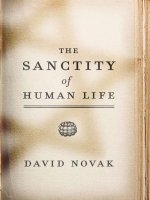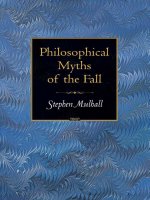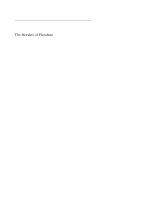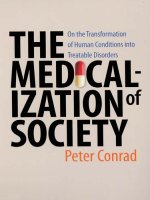princeton university press the morality of pluralism may 1993
Bạn đang xem bản rút gọn của tài liệu. Xem và tải ngay bản đầy đủ của tài liệu tại đây (1.52 MB, 239 trang )
The Morality of Pluralism
The Morality of Pluralism
John Kekes
PRINCETON UNIVERSITY PRESS
PRINCETON, NEW JERSEY
Copyright 1993 by Princeton University Press
Published by Princeton University Press, 41 William Street,
Princeton, New Jersey 08540
In the United Kingdom: Princeton University Press,
Chichester, West Sussex
All Rights Reserved
Library of Congress Cataloging-in-Publication Data
Kekes, John.
The morality of pluralism / John Kekes.
p. cm.
Includes bibliographical references and index.
1. Pluralism. 2. Values. 3. Ethics. I. Title.
BJ1031.K24 1993 171′.7—dc20 92-40492 CIP
ISBN 0-691-03230-0 (alk. paper)
This book has been composed in Adobe Baskerville
Princeton University Press books are printed on acid-free paper
and meet the guidelines for permanence and durability
of the Committee on Production Guidelines for Book Longevity of
the Council on Library Resources
Printed in the United States of America
10987654321
For J.Y.K.
Contents
Acknowledgments xi
CHAPTER ONE
3Introduction: Setting the Stage
Is Our Morality Disintegrating? 3
9A Preliminary Sketch of Pluralism
15The Plan of the Book
CHAPTER TWO
17The Six Theses of Pluralism
The Plurality and Conditionality of Values 17
21The Unavoidability of Conflicts
23The Approach to Reasonable Conflict-Resolution
27The Possibilities of Life
31The Need for Limits
34The Prospects for Moral Progress
37Conclusion
CHAPTER THREE
38The Plurality and Conditionality of Values
Primary and Secondary Values 38
44Moral and Nonmoral Values
46Overriding and Conditional Values
48Pluralism versus Relativism
CHAPTER FOUR
53The Unavoidability of Conflicts
The Incompatibility and Incommensurability of Values 53
60Conflicts
63The First Version of Monism: A Summum Bonum
67The Second Version of Monism: The Fungibility of Values
The Third Version of Monism: A Canonical Principle
74for Ranking Values
CHAPTER FIVE
76The Nature of Reasonable Conflict-Resolution
A Pluralistic Approach to Conflict-Resolution 76
80Conventions and Traditions
viii
.
Contents
85Commitments and Conceptions of a Good Life
89The Prospects for Conflict-Resolution
92Integrity and Reasonable Commitments
CHAPTER SIX
99The Possibilities of Life
Moral Imagination 99
104The Exploratory Function of Moral Imagination
107The Corrective Function of Moral Imagination
111Increasing Freedom
116Conclusion
CHAPTER SEVEN
118The Need for Limits
Moral Imagination and Deep Conventions 119
121Life as a Primary Value
125The Morality of Live Burial
127Relativism Redux?
132Monism Redux?
CHAPTER EIGHT
139The Prospects for Moral Progress
Moral Progress in General 139
142The Nature of Shame
147Forms of Shame
152The Possibility of Moral Progress
159Conclusion
CHAPTER NINE
Some Moral Implications of Pluralism: On There Being
161Some Limits Even to Morality
Reasonable Immorality 163
168Pluralism beyond Morality
172Against the Overridingness of Morality
CHAPTER TEN
Some Personal Implications of Pluralism: Innocence Lost
179and Regained
Prereflective Innocence 180
184The Loss of Prereflective Innocence
190Reflective Innocence
197Conclusion
Contents
.
ix
CHAPTER ELEVEN
Some Political Implications of Pluralism: The Conflict
199with Liberalism
Liberalism and Pluralism 199
203The Neutrality Thesis
211Beyond Neutrality: The Politics of Pluralism
Works Cited 219
Index 225
Acknowledgments
THE STRONGEST influences on the views presented in this book are the
writings of Isaiah Berlin and Michael Oakeshott. Their influences are
present, not so much by way of arguments, but through their manner of
thinking, which, it is hoped, informs the thoughts here presented. Since
Berlin is a liberal and Oakeshott a conservative, it may be doubted that
their influences are compatible. One of the happy consequences of plu-
ralism, however, is that this doubt is misplaced.
Individual chapters of the book were read and most helpfully com-
mented on by Chong Kim Chong, Felmon Davis, Jean Y. Kekes, and
Ernest Schlaretzki. Their help is gratefully acknowledged.
A different sort of debt is owed by the author to two people at Prince-
ton University Press: Ann Himmelberger Wald, philosophy editor, who
eased the progress of the book from submission, through revision, to
acceptance; and to Beth Gianfagna, production editor, who guided its
transformation into a proper book—a process that is becoming a cus-
tom, since this is the author’s fourth book that she helped to make bet-
ter. It is with pleasure that a further indebtedness is acknowledged to
Carol Roberts, copy editor, for acutely finding and tactfully pointing out
the numerous inconsistencies, infelicities, and downright errors that the
typescript contained.
Six of the chapters include previously published material: chapter 1
makes use of parts of “Is Our Morality Disintegrating?” Public Affairs
Quarterly 1(1987): 79–94; chapter 6 is a revised version of “Moral Imagi-
nation, Freedom, and the Humanities,” American Philosophical Quarterly
28(1991): 101–11; chapter 7 is a revised version of “Pluralism and the
Value of Life,” Social Philosophy and Policy 10(1994, in press); chapter 8 is
a revised version of “Shame and Moral Progress,” Midwest Studies in Phi-
losophy 13(1988): 282–96; chapter 9 is a revised version of “On There
Being Some Limits to Morality,” Social Philosophy and Policy 8(1991): 63–
80; and chapter 11 is a revised version of “The Incompatibility of Liberal-
ism and Pluralism,” American Philosophical Quarterly 29(1992): 141–51.
A previous version of chapter 1 was discussed at a conference organ-
ized by the Institute for Humane Studies; previous versions of chapters
7 and 9 were presented at conferences organized by the Social Philoso-
phy and Policy Center; a previous version of chapter 8 was read at the
National University of Singapore, as were previous versions of chapter 9
at Duke University and chapter 11 at Evergreen State College. The com-
ments received on these occasions helped to improve the arguments,
and they are hereby acknowledged with pleasure and gratitude.
xii
.
Acknowledgments
This book is a companion volume of Moral Tradition and Individuality
and Facing Evil, both published by Princeton University Press, the first in
1989 and the second in 1990. Each of the three books is intended to be
independent, but some overlap among them is unavoidable, since they
represent different aspects of the same moral point of view. Readers are
asked, therefore, to excuse the several references to these other books.
The references indicate where fuller arguments may be found; they are
not meant as self-advertisements.
The Morality of Pluralism
CHAPTER ONE
Introduction: Setting the Stage
The purpose of the inquiry is not to define a word, but to detect
the secret of what we enjoy, to recognize what is hostile to it, and
to discern where and how it might be enjoyed more fully.
—Michael Oakeshott, “The Political Economy of Freedom”
IS OUR MORALITY DISINTEGRATING?
The morality in question is the Western one. It is an amorphous, com-
plex, constantly changing system of ideals, principles, customs intended
to guide our conduct. It is derived from three main sources: ancient
Greece and Rome; the Judeo-Christian religious tradition; and the
thought and sensibility of the Renaissance, the Enlightenment, and sec-
ular humanism. According to a substantial body of considered contem-
porary opinion, our morality is disintegrating.
1
It is conceded that in the normal course of events many of us, more or
less conscientiously, continue to live according to morality, but its hold
on us, it is supposed, gets weaker and weaker. When life goes smoothly,
old moral habits still prevail, but, increasingly, life does not go smoothly.
We are continually challenged both externally by alien moralities and
internally by noxious left- and right-wing extremism, cynicism, a spread-
ing failure of nerve, and the terrible simplicities of fundamentalists of
various persuasions. In the face of these challenges, we need to be able
to justify our moral values if we are to have an acceptable way of living
together. It seems, however, that we cannot do so. Neither the religious
appeal to God nor the humanistic reassurance about our basic goodness,
rationality, and perfectibility carries sufficiently widespread conviction
to save the day. As a result, we cling to our morality as to an article of
faith.
1
The following are some representative opinions: “In thinking about what has gone
wrong, we need to see [that] what . . . has failed at every level—from the society of nations
to the local community to the family—is integration.” Also, “Our problems today are . . .
moral” (Bellah et. al., Habits of the Heart, 284 and 295). “The various meanings, values and
beliefs operative in a society were ultimately ‘held together’ in a comprehensive interpreta-
tion of reality. . . . Religion . . . makes possible to man to feel ‘at home’ in the universe. This
age old function of religion is seriously threatened. . . . The final consequence of all this
[is that] . . . modern man has suffered from a deepening condition of ‘homelessness’”
4
.
Chapter One
The challenges to our moral convictions, however, force us to ques-
tion our faith and drive us to doubt that we can offer a better reason for
our beliefs than the challengers can for theirs—yet theirs we reject. We
are gnawed by the growing suspicion that our adherence to our values
reflects centuries of moral conditioning, but it has no rational warrant.
Our morality is disintegrating, it is said, because we are unable to assuage
this suspicion. We are consequently helpless in the face of challenges.
There was a time, we are told, when our morality did provide clear stan-
dards of good and evil, generally accepted rules for living together, and
it gave meaning and purpose to our lives. It no longer performs these
all-important functions; we have nothing to put in its place, and so
the disintegration of morality is producing a cultural crisis of the first
order.
The disintegration thesis derives from the observation of deep
changes affecting our morality and from the interpretation that these
changes are so deep as to present a fundamental threat to our morality.
What, then, are these deep changes supposed to be? If we observe pre-
vailing moral opinion, we cannot fail to notice that divorce, homosexual-
ity, and extramarital sex, for instance, are subject to much less censure
than they were fifty years ago and that we have become morally alive to
matters toward which our predecessors were largely indifferent, such as
ecology, animal experimentation, and affirmative action. But these
changes are insufficient to substantiate the claim that our morality as a
whole is undergoing deep changes. For any reasonable morality is
bound to be constantly changing, because moral values must be adjusted
to fit changing economic, technological, political, demographic, and
other circumstances. Such adjustments, however, are not particularly
difficult. We used to see homosexuality as harmful, but we are becoming
convinced that homosexuals are no better or worse than others, and so
(Berger et al., The Homeless Mind, 78–82). “[A] mood of pessimism in higher circles . . .
spreads through the rest of society as people lose faith Thepolitical crisis of capitalism
reflects a general crisis of western culture” (Lasch, The Culture of Narcissism, xiii). “If my
account of our moral condition is correct . . . the new dark ages . . . are already upon us. . . .
This time however the barbarians are not waiting beyond the frontiers; they have already
been ruling us for quite some time” (MacIntyre, After Virtue, 263). “[P]revailing value sys-
tems offer no convincing answers to such questions as why individuals should under some
circumstances be prepared to subordinate their particular ends to the common good. . . .
[Thus] public confidence in standards of decency and fairness . . . must eventually crum-
ble” (Reichly, Religion in American Public Life, 341). “Many spokesmen for our established
normative institutions are aware of their failure and yet remain powerless to generate . . .
the necessary . . . faith. . . . Our . . . general misery is that, having broken with those institu-
tionalized credibilities from which . . . moral energy derived, new credibilities are not yet
operationally effective” (Rieff, The Triumph of the Therapeutic, 18–19).
Introduction
.
5
we are changing our minds about the harm it does. This change, how-
ever, alters our morality no more significantly than Christian morality
was altered by the growing conviction that witches should not be burned.
A morality has a hard center and a soft periphery. Changes are natural
and expected on the periphery, but they leave the center unaffected. To
point to some ways in which the moral values of a period differ from
those of the previous one may, therefore, provide evidence for no more
than the most routine moral change.
The argument for deep moral change is that the change in our values
has spread from the periphery to the center. It is not just that our
attitudes toward divorce, homosexuality, and extramarital sex have
changed, but also that our changing attitudes reflect our uncertainty
about the relations between men and women and about the place and
importance of sex in our lives. We are repudiating racism, but that
brings us face-to-face with fundamental questions about how much we
are willing to sacrifice for equality; how far we are willing to rely on the
law to enforce a particular moral point of view; or what, if anything, we
owe to the descendants of people victimized by our ancestors. And it is
not just sex and racism that force deep questions on us. Civil disobedi-
ence, drug abuse, capital punishment, the increasing power of bureauc-
racy and corporations, the demands of patriotism, starvation and torture
in distant foreign places, euthanasia, vivisection, abortion, and so on and
on, all contribute to a basic questioning of the values by which we have
been living.
The sea of moral conflicts threatens to drown us. There seems to be
nothing to which we can appeal without our opponents calling its cre-
dentials into question. We are all for equality and we are all for freedom.
But what do we do when they conflict? We all recognize the necessity of
the law, but what if the law is used to perpetuate injustice? No one is for
censorship, but does that mean that we should allow children to copu-
late with animals in pornographic films? The conflicts are so numerous,
so varied, permeate so many different areas of our lives; the arguments
about them are so hopelessly inconclusive, carry so little conviction; and
the opponents are so deeply imbued with their sharply conflicting moral
fervor, that the fact of basic moral change is undeniable.
The question is whether this basic change amounts to disintegration.
Why should we suppose that our morality is cracking under the strain?
Because, defenders of the disintegration thesis reply, it lacks the re-
sources to resolve moral conflicts. The sign of disintegration is not that
there is a lot of immorality around. The rot goes deeper than that. In-
deed, the prevalence of immorality presupposes the existence of values
that the people or actions judged to be immoral violate. Rather, we face
disintegration because there is a general confusion about values. The
6
.
Chapter One
salient fact is not immorality, but moral confusion. Our trouble is that we
no longer know how far our morality extends; we have become confused
about the distinction between the moral and the nonmoral.
The disagreement between supporters and critics of abortion, eutha-
nasia, suicide, animal experimentation, divorce, homosexuality, or our
use of natural resources is not that one side regards the conduct in ques-
tion as morally good, while the other thinks of it as morally bad. The
dispute is whether moral judgments are normally appropriate. Defend-
ers of these practices want to exempt them from moral judgment alto-
gether or regard them as only incidentally subject to reasonable moral
concern. Their opponents insist that the practices are central to moral-
ity. Suicide, for instance, is said to be morally wrong because the deliber-
ate killing of a human being is wrong. Opposed to this is the claim that
moral considerations apply only if the victim is someone else; how peo-
ple dispose of their lives is, in normal circumstances, entirely up to them.
Just as one can argue whether a particular action comes under legal
jurisdiction, so one can argue about the relevance of morality to it. We
are facing moral disintegration, it is said, because so many of our con-
flicts are about the appropriateness of moral considerations. Our confu-
sion is not about whether we should praise or blame, but whether praise
or blame are fitting responses. And the source of this confusion is that we
no longer know what constitutes a moral question.
This confusion is not caused by the shrinking of morality. It is true that
our morality is contracting in some ways; extramarital sex, suicide, and
divorce, for instance, are beginning to be exempted from moral cen-
sure. But in other ways our morality is expanding because animal exper-
imentation, smoking, spreading AIDS, and advertising are becoming
moral issues. It would be a mistake, therefore, to diagnose the source of
moral confusion as the liberal tendency not to count as moral what con-
servatives count as such. Liberals are just as morally engaged as conserva-
tives. The difference is that they tend to care about different issues.
Liberals tend to be morally concerned about equality, sexual freedom,
capital punishment, and commercialism; conservatives tend to direct
moral attention to the family, social order, and the free market. Some-
times the two sides meet and argue because they recognize that the issue
is how to balance the competing claims, say, of freedom and equality, or
sexual experimentation and family life. But even in these rare cases,
when there is sufficient common ground to begin to argue, the argu-
ment is bound to end in an impasse, because there is no moral authority,
no value, that both sides are willing to accept. If the issue is pressing,
there will be a contrived legal or political compromise, but it will leave
everyone dissatisfied. What thinking person in our society can be satis-
Introduction
.
7
fied with the morality of the compromises we have arrived at, after de-
cades of haggling, about pornography, abortion, the hundreds living on
death row, the welfare system, or the measures taken to ensure the hon-
esty of politicians?
But the fact is that it rarely happens that opponents can even begin to
argue. For what can a right-to-life advocate say that would persuade a
militant feminist, a gay liberationist to a moral majoritarian, a champion
of law and order to a lawyer specializing in getting criminals acquitted on
technicalities, a Mormon to a hippie, a marine to a transcendental med-
itator, or, for that matter, a philosophy professor to a junkie? The moral
sensibilities of these people are so far apart that there is no common
ground for one even to explain to the other his or her position. Or so the
disintegration thesis goes.
The result is that informed moral debate is disappearing from our
society. In its place, we have cynical or despairing indifference or an
assertive shrillness masquerading as moral indignation. This is the state
of affairs Yeats laments in The Second Coming:
Things fall apart; the center cannot hold;
Mere anarchy is loosed upon the world,
The blood-dimmed tide is loosed, and everywhere
The ceremony of innocence is drowned;
The best lack all conviction, while the worst
Are full of passionate intensity.
The disintegration thesis, then, is that “things fall apart; the center can-
not hold,” because we have lost a rational foundation for our moral con-
victions. Inevitable moral change turns into moral decay. Our confusion
about our values leads to intractable moral conflicts and these, in turn,
create a climate of opinion in which everything is questionable and no
question has a reasonable answer. “The best lack all conviction, while the
worst / are full of passionate intensity.”
The disintegration thesis is a powerful challenge to our moral convic-
tions, but it is mistaken. Moral conflicts are indeed prevalent, but they
betoken change, not disintegration. We are witnessing the new strug-
gling to be born, not the death throes of the old. Our morality is chang-
ing in deep ways, but it is still our morality: alongside discontinuity, there
is substantial continuity. The disintegration thesis is not mistaken about
the facts but about the interpretation of the facts. What defenders of it
observe is there, but it is not as they interpret it.
The deep moral changes do indicate that something is disintegrating;
it is, however, not our morality but merely a particular conception of it.
The reason why the disintegration thesis misinterprets our present
8
.
Chapter One
moral situation is that it mistakenly identifies our morality with this con-
ception, and it mistakenly supposes that as it becomes untenable, so our
morality is itself threatened. The disintegration thesis recognizes only
two alternatives—the acceptance or the rejection of a particular concep-
tion of morality—and it falsely supposes that our morality itself stands or
falls with the fortunes of that conception.
The conception of morality that defenders of the disintegration thesis
have in mind is monistic. Monism is the view that there is one and only
one reasonable system of values. This system is the same for all human
beings, always, everywhere. Human lives are good to the extent to which
they conform to this system, and particular values are better or worse
depending on their standing in the system. It is acknowledged, of
course, that countless people do not conform to it. The reason for this is
sought, however, in the deviating people, not in the system of values that
the conception embodies. People are supposed to deviate either be-
cause they are insufficiently reasonable or because they are handicapped
by character defects or adverse circumstances. According to monists, the
task of morality is to create institutions, formulate principles, and edu-
cate people so as to further their living and acting according to this one
reasonable system of values. Since deep moral changes are symptomatic
of our radical disagreements about the nature of this system, given the
monistic interpretation of morality, it will seem that our morality is disin-
tegrating.
The alternative that monists fear may replace their position is relativ-
ism, the view that ultimately all values are conventional. Human life
would be inconceivable without values, but what values people accept
depends on the context in which they were born, on their genetic inher-
itance and subsequent experiences, on the political, cultural, economic,
and religious influences on them; in short, what they value depends on
their subjective attitudes and not on the objective features of values. The
implication of relativism is that there cannot be a uniquely reasonable
system of values, because when all is said and done no value any concep-
tion embodies can be justified on objective grounds.
What defenders of the thesis interpret as the disintegration of morality
is the gradual replacement of monism with relativism. They observe our
moral conflicts, the deep moral changes, the loss of our old certainties,
our growing despair, and our distrust of reason—and they interpret
them as monism yielding to relativism. But this interpretation is mis-
taken, because monism and relativism do not exhaust our moral options
and because there is a better interpretation of the observed facts of our
moral life. The additional option and the better interpretation are both
provided by pluralism.
Introduction
.
9
APRELIMINARY SKETCH OF PLURALISM
Pluralism is a theory about the nature of the values whose realization
would make lives good.
2
The primary concern of pluralism is with the
relation in which these values stand to each other; the identity of the
values is of interest to pluralists, qua pluralists, only in so far as it is rele-
vant to understanding their relations. Pluralism thus is a theory only
about one aspect of good lives. Pluralists may disagree with each other
and agree with non-pluralists about the identity of the values that
warrant our allegiance.
The goodness of a life may be thought to depend either on the per-
sonal satisfaction it provides to the agent or on the moral merit it pos-
sesses. Discussions about what makes a life good are therefore ambigu-
ous, and clarity requires removing the ambiguity. A life will be called
here “good” only if it is both personally satisfying and morally meritori-
ous. Either component alone would not be sufficient to make a life
good. For personal satisfaction may be obtained at the cost of causing
much evil, and the price of moral merit may be the frequent frustration
of reasonable desires, and neither evil nor frustrated lives should be sup-
posed to be good.
The signs of a life’s being good, then, are that the agent is satisfied
with it, does not look to change it in radical ways, does not regret the
major decisions that have shaped the life, does not feel lastingly unful-
filled, and would be content to let the life continue in the direction that
has been given it. But it is equally important for the goodness of a life
that the balance between the good and the evil that the agent has caused
in its course be preponderantly in favor of the good. For its being reason-
able to claim that a life is good, the judgment of the agent should concur
with the judgment of knowledgeable observers of the life, and both judg-
ments should be grounded on lasting personal satisfaction and overall
moral merit being reasonably attributed to the agent.
Thinking of a good life in this way requires understanding the relation
between its good-making components.
3
One possibility is that personal
satisfaction and moral merit are unrelated aspects of a good life. But this
2
In contemporary philosophy, “pluralism” is used also to denote a metaphysical theory,
often referred to as “systematic pluralism.” The version of monism that is the subject of this
book is a theory only about the nature of values and it makes no metaphysical claims
beyond those that concern values. Perhaps the best source of information about systematic
pluralism is a collection of essays—Ford, ed., Systematic Pluralism. For a survey of some of the
different forms pluralism of values may take, see Amelie Rorty, “Varieties of Pluralism in a
Polyphonic Society.”
3
For a discussion of this point, see Nagel, The View from Nowhere, chapter 10.
10
.
Chapter One
is implausible, because it is not morally indifferent what personal satis-
factions an agent seeks, because whatever is morally meritorious is often
also personally satisfying, and because a good life normally excludes the
inconsistency of motives and actions that the existence of unrelated
good-making aspects is likely to produce.
Another possibility is that what makes a life good is that the personal
satisfaction and the moral merit it yields coincide. In such a life, what the
agent finds personally satisfying is the same as what has moral merit. One
difficulty with this is that the coincidence of the two good-making aspects
can only be partial at best, because reasonable agents often derive per-
sonal satisfaction from experiences and activities that are normally mor-
ally neutral. Connoisseurship, aesthetic pleasure, peak physical condi-
tion, a sense of humor, artistic creativity, the cultivation of style, and so
forth, are usually personally satisfying without possessing either moral
merit or demerit. We should recognize, therefore, that personal satisfac-
tion may derive from the realization of both moral and nonmoral values,
and, consequently, living a good life—whose achievement is the aim of
pluralism—is not entirely a question of moral good and evil.
Living a good life, therefore, is not the same as living a moral life, for
good lives have both moral and nonmoral components, and personal
satisfaction is usually derived from both. Conceptions of a good life are
broader, more inclusive than conceptions of a moral life. Yet the relation
between the two is not simply that a good life is a moral life with some
personal satisfactions derived from nonmoral sources being added to it.
For one of the complications to which pluralism gives rise is that the
moral and nonmoral components of a good life may conflict, and it may
be reasonable, in some circumstances, to resolve the conflict in favor of
the nonmoral component. We must postpone consideration of this com-
plication, however, until chapter 9.
Nevertheless, pluralism is an evaluative theory, because it is not an
uncommitted analysis of the relations among various types of values in-
volved in good lives but a theory motivated by a concern for human
beings actually living good lives. Consequently, pluralism is at once de-
scriptive and evaluative. It offers a description of some conceptual and
factual features relevant to good lives, but it also undertakes to evaluate
these features on the basis of their contribution to good lives. The result
of this evaluation may be to justify the descriptively identified features,
or it may be to criticize them. But the evaluation, and thus the justifica-
tion or the criticism, proceeds from a point of view that is centrally con-
cerned with enhancing the chances of human beings to live good lives.
It may be asked whether pluralism, thus understood, is a moral theory.
The answer depends on how broadly we wish to conceive of moral theo-
ries. There is ample historical precedent for regarding theories about
Introduction
.
11
good lives as moral. Indeed, this is the central concern of the eu-
daimonistic theories of Plato, Aristotle, the Stoics, and their contempo-
rary followers.
4
In this broad sense, pluralism is a moral theory. But there
is also a tendency in moral philosophy to restrict moral theories to the
domain of moral values. The Kantian tradition is perhaps the most un-
compromising example of this approach.
5
In this narrower sense, plural-
ism is not a moral theory.
No substantive issue turns on which usage is followed. What matters is
that pluralism is a theory about good lives. According to it, good lives
depend on both personal satisfaction and moral merit, and personal
satisfaction depends on the realization of both moral and nonmoral val-
ues. We shall refer to pluralism as a moral theory, interpreted in the
broad sense, mainly to stress the connection between morality and good
lives, even though good lives admittedly have a nonmoral dimension.
The basic belief that unites pluralists is that good lives require the
realization of radically different types of values, both moral and non-
moral, and that many of these values are conflicting and cannot be real-
ized together. Living a good life requires the achievement of a coherent
ordering of plural and conflicting values, but coherent orderings are
themselves plural and conflicting. Thus, just as there is a plurality of
conflicting values, so also is there a plurality of conflicting conceptions
of a good life comprising these values. The plurality of good lives, there-
fore, is a plurality twice over: on account of the values it embodies and on
account of the ways in which coherence among the values is achieved.
The key descriptive thesis of pluralism is that central features of good
lives, as they are conceived in contemporary Western circumstances, at
any rate, are best understood in pluralistic terms. These features are,
first, that we are motivated by various moral values, such as the common
good, duty, personal ideals, love and friendship, self-development, loy-
alty, justice, human rights, and so on. Second, that we are also motivated
by nonmoral values of different sorts, for instance, beauty, playfulness,
physical well-being, career plans, creativity, adventure, style, and the like.
Third, that we often encounter conflicts in which we feel the tension
between and among moral and nonmoral values, and these values moti-
vate contrary choices and courses of action. Fourth, a sense of loss often
accompanies the choices and actions our values require because, al-
though we do what we feel it is, on balance, reasonable to do, we are
nevertheless often forced in this process to sacrifice important values.
And last, we often experience conflicts, not merely within morality, but
4
A contemporary version of the theory is developed in Kekes, Moral Tradition and Individ-
uality.
5
For the dispute between eudaimonism and Kantianism, see Kekes, Moral Tradition and
Individuality, chapter 2.
12
.
Chapter One
between morality and such other dimensions of life as politics, aesthet-
ics, intimate personal relationships, or a reasonably interpreted concep-
tion of self-interest.
The central evaluative claim of pluralism is that although our commit-
ments to various moral and nonmoral values produce conflicts and the
resolution of these conflicts unavoidably engenders loss, nevertheless
the plurality of values is not a regrettable feature of our life but a positive
value. For the plurality of values enriches the possibilities for our living
good lives, increases our freedom, motivates us to assert greater control
over the direction of our lives, and enlarges the repertoire of concep-
tions of life that we may recognize as good. The evaluative claim of plu-
ralism, of course, has serious moral, personal, and political implications,
which will be discussed in chapters 9, 10, and 11.
Pluralism is a recent moral theory, although there were thinkers be-
fore our times whose approach was receptive to pluralism. Aristotle,
Montaigne, Hume, John Stuart Mill in On Liberty, and William James
come readily to mind. Yet not even they were unambiguously pluralists,
as the term is understood here, mainly because pluralism was not yet a
category of thought with respect to which they were obliged to clarify
their positions. It is easier to identify contemporary thinkers who have
been struggling in recent years with the more or less systematic develop-
ment of pluralism: Annette Baier, Isaiah Berlin, Richard Brandt, Stuart
Hampshire, Thomas Nagel, David Norton, Martha Nussbaum, Michael
Oakeshott, Edmund Pincoffs, John Rawls, Michael Stocker, Peter Straw-
son, Charles Taylor, and Bernard Williams are some who have published
influential books or articles on the topic.
6
Pluralism, then, is a moral theory, in the broad sense, but there are
serious doubts about the possibility and desirability of having any moral
theories at all.
7
These doubts derive from the supposition that a success-
ful moral theory would have to provide universal and impartial princi-
ples of moral evaluation. If this supposition were correct, “pluralistic
moral theory” would be oxymoronic. Pluralists naturally share the
doubts about morality requiring exclusively universal and impartial prin-
6
Annette Baier, Postures of the Mind; Berlin, Four Essays on Liberty; Brandt, A Theory of the
Good and the Right; Hampshire, Morality and Conflict and Innocence and Experience; Nagel,
“The Fragmentation of Values”; Norton, Personal Destinies; Nussbaum, The Fragility of Good-
ness; Oakeshott, Rationalism in Politics and On Human Conduct; Pincoffs, Quandaries and
Virtues; Rawls, A Theory of Justice and “Justice as Fairness: Political Not Metaphysical”;
Stocker, Plural and Conflicting Values; Strawson, “Social Morality and Individual Ideal”;
Charles Taylor, Sources of the Self; and Williams, Problems of the Self, Moral Luck,andEthics and
the Limits of Philosophy.
7
See the anthology of representative writings by Clarke and Simpson, Anti-Theory in Ethics
and Moral Conservatism, Edwards, Ethics without Philosophy, and Louden, “Virtue Ethics and
Anti-Theory” and Morality and Moral Theory.
Introduction
.
13
ciples, yet this does not doom the effort to develop a pluralistic moral
theory. For theories in morality may aim at thinking systematically about
diverse moral phenomena, considering how moral judgments could be
reasonably criticized or justified, and arriving at some coherent view of
the nature of the values that may make life good. And one can aim to do
these without supposing that success would have to yield only universal
and impartial principles. It is in this sense, then, that pluralism is a moral
theory.
8
It may be asked whether it is an ethical or a metaethical theory. It is
arguable whether this distinction is tenable, but if it is, then the answer
is that pluralism is both. For it is concerned both with first-order moral
phenomena, such as various values and their relations to each other, and
with the second-order analysis, justification, and criticism of the judg-
ments we make about first-order moral phenomena.
Another distinction in terms of which moral theories are currently
classified is between cognitive and noncognitive theories. This distinc-
tion is neither sharper nor clearer than the previous one. Calling moral
theories “cognitive” may mean that the moral judgments that follow
from them are open to rational evaluation and can be criticized or justi-
fied on objective grounds independent of the theory. In this sense, plu-
ralism is certainly cognitive. But “cognitive” may be used in contrast with
“emotive,” and it is taken then to mean that the source of moral motiva-
tion is reason rather than feeling, imagination, or the will. And in that
sense, it is unclear whether pluralism is cognitive. If this sense of “cogni-
tive” commits one to holding that reason is or ought to be the exclusive
source of moral motivation, then pluralism is noncognitive. But if this
second sense of “cognitive” is taken to permit, in addition to reason, also
feeling, imagination, and the will as morally acceptable motivating
forces, then pluralism is cognitive in the second sense as well. The main
point is not the label, but what it signifies. In the present case, that is the
claim that the moral judgments that follow from pluralism can be justi-
fied or criticized on objective grounds and, furthermore, the concep-
tions of a good life that pluralists regard as reasonable are sufficiently
capacious to leave room for the moral importance of feeling, imagina-
tion, and the will, as well as of reason.
In holding this ideal, pluralists partly agree and partly disagree with
both monists and relativists. In agreement with monists and in disagree-
ment with relativists, pluralists claim that a conception of a good life
must be reasonable if it is actually to yield a good life. And that means
that the plurality of values and their comparative rankings that the con-
8
For a discussion of the issues involved in this approach, see the special issue of Ethics,ed.
Becker, “Impartiality and Ethical Theory.”









